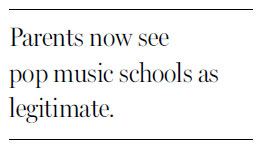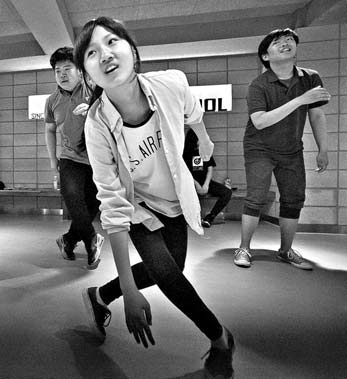Korean cram schools aim at K-Pop stardom
Updated: 2013-08-25 09:21
By Choe Sang-Hun(The New York Times)
|
|||||||
|
At Def Dance Skool in Seoul, 1,000 students hone their K-pop skills. Jean Chung for The International Herald Tribune |

SEOUL, South Korea - Kim Chae-young attends cram school five evenings a week, toiling deep into the night. But unlike most young South Koreans who spend hours at special schools to polish their English and math, she studies slide steps and bubbly lyrics.
"I want to become a K-pop icon, one like Psy," said Chae-young, 13, referring to the Korean rapper of the viral video "Gangnam Style." "All these hours I spend here are my investment for that dream."
For four years, she has practiced her hip-hop moves at the Def Dance Skool in Seoul, which is among thousands of such schools in South Korea. Even traditional private music and dance schools - more accustomed to teaching Bach and ballet - have switched their curriculums to get with the pop plan.
They are responding to a growing demand. In a survey by the Korea Institute for Vocational Education and Training last year, entertainers, along with teachers and doctors, were the most popular choices for future jobs among students - a far cry from a more traditional era, when entertainment was considered an inferior profession. Now pop music is one of the most coveted college majors, where it's "practical music."
"Eleven years ago, when I first started this school, parents thought only teenage delinquents came here," said Yang Sun-kyu, head of Def Dance Skool. "Parents' attitudes have changed."
That's because, in large part, career choices have expanded for their children. The golfer Se Ri Pak dominated on the Ladies Professional Golf Association tour, and the figure skater Kim Yu-na won an Olympic gold medal. Then along came Park Jae-sang, known as Psy, with his lasso-swirling, clip-clopping "Gangnam Style" dance steps and lyrics that poked fun at South Korea's rigid social structure.
The Def Dance Skool trains 1,000 students, up from about 400 in 2006. Almost half of the students are trying to break into one of South Korea's top K-pop agencies, which recruit and train young talent to put them into girl or boy bands.
Some of these South Korean "idol groups," including Girls' Generation, Super Junior and Big Bang, produce music videos that generate millions of views on YouTube. Fans from across Asia and elsewhere travel to South Korea to attend their album releases, concerts and awards ceremonies.
Sales of South Korea's top three K-pop agencies - SM Entertainment, YG Entertainment and JYP Entertainment - soared to 362.9 billion won, or about $326 million, last year, from 106.6 billion won in 2009.
"In my days, studying hard was everything, but now we see there are other options for our children," said Lee Byeong-hwa, a 48-year-old homemaker whose 11-year-old daughter, Kim En-jae, dreams of a career as a K-pop star.
On a recent day, Ms. Lee and En-jae sat with thousands of young people at an indoor stadium in Incheon, west of Seoul.
They were among two million contestants vying to appear on "Superstar K," the country's answer to "American Idol." It was 18-year-old Woo Ji-won's third year of trying. "My classmates are cramming for college entrance exams," she said. "But I go to a K-pop school seven evenings a week. After coming home past 10, I study K-pop video on YouTube for hours."
Critics say South Korea is producing unimaginative performances. Hong Dae-kwang, who ranked fourth at "Superstar K" last year, shared those reservations, but also said the K-pop boom helped to change his life. Where he once shared a one-room apartment, delivered pizza and performed on the streets, now he is a regular guest on a radio show, lives in a three-room apartment and has an agent.
Mr. Hong, whose debut album briefly topped digital song downloads here in April, said, "K-pop opened the door of opportunities for people like me."
The New York Times
(China Daily 08/25/2013 page12)
